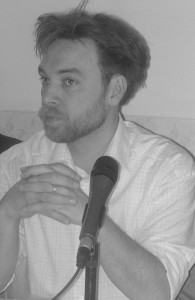
On Thursday 11th February, the Annual Conference 2010 hosted a new guest: Carl Henrik Fredriksson came from Vienna to speak about the translator’s political and cultural context. Reflecting on the question “how much in common must a community have?” seminar participants embarked on a two-hour discussion of the European public sphere.
Fredriksson is Co-Founder and Editor-in-Chief of Eurozine, an online magazine and a network of European cultural journals. He is President of the association Eurozine – Verein zur Vernetzung von Kulturmedien, and former Editor-in-Chief of Sweden’s oldest cultural journal, Ord&Bild.
The core problematic discussed in the lecture was the difficulty of identifying a shared European identity. In Europe, most people have a national or a local identity, and sometimes perhaps a regional one, but “in the absence of a shared European identity, there is no true and sustainable European community”, argued Fredriksson. In an era in which every institution is viewed in terms of global relationships, he claimed, the role of the state has had to be rethought.
“The State can no longer be defined in national terms. It has become an international actor. Therefore the fourth estate – journalism, the press – also has the obligation to define itself in those terms,” says Fredriksson. He adds: “If politics has changed, then of course the entity that is supposed to oversee it also has to change. This however has not yet happened. Daily newspapers are still very much nationally defined”.
Faculty member Ryan Plumley queried the possibility of a common transnational public sphere: “Aren’t publics always multiple, terribly fragmented, and indeed aren’t all forms of publication oriented towards a specific public?” Fredriksson responded that in fact certain sources within the public sphere always carry more weight than others: “this is why big investors want to buy a newspaper, because they want to put out a certain political message,” explained Fredriksson. “Yes, there has always been fragmentation in the public sphere, but newspapers – and that is one of the problems here – have played the key role in nation building. That is exactly what newspapers are for: they have created a national community, built that community.” Print and visual media continue to reinforce the national identity and strengthen particular political possibilities, while undermining and ruling out others.
Fredriksson argued that, when discussing how to build a public sphere, it is better to talk about practices and not values, since this latter term will shift the focus to how identity is constructed and defined. He gave two examples of how a transnational public sphere can put practical pressure on the assumptions and self-perceptions of the national space.
One was of a series of articles written by a Swedish journalist of Polish origin, about the forced sterilization policy implemented in Sweden from the 1930s to the 1950s. None of the evidence presented in the articles was new—it had even been uncovered by Swedish researchers—but they were eventually translated into English. As a result, the Swedish government received inquiries from the international media about whether the victims would be given compensation.
A similar outcome followed the case of a Norwegian journalist who, on the occasion of the anniversary of the end of the Second World War, chose not to write about his compatriots’ resistance to Nazi occupation, but rather about anti-Semitic persecution in Norway before the War. Once the article was translated and reached a wider audience, the authorities were forced to commit themselves to providing compensation.
ECLA Dean Thomas Nørgaard raised his worry that in the search for a common public sphere, there would be a simplification of certain issues which might encourage the emergence of a superficial or frivolous culture. In response, Fredriksson cited Eurozine as a publication which could be the model, if not the basis, for a new public sphere. A project which grew gradually from the participation of journalists and translators over a number of years, Eurozine is a network of European cultural journals, linking more than seventy-five partner journals as well as associated magazines and institutions from nearly all European countries.
Publishing articles in their original language, it also offers an accompanying translation into English. Eurozine’s use of the internet as a mechanism of distribution rather than a technology which often downgrades content—forcing it into abbreviated or hastily digestible forms—reflects Fredriksson’s ambitions for the European public sphere, as a space which borrows its character from the traditional high quality and identity-building function of the national newspaper.
by María Cruz (AY ’10, Argentina)
